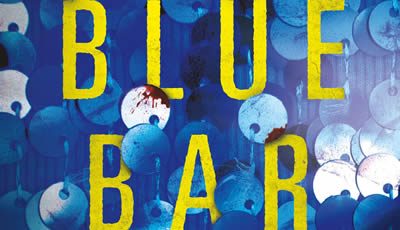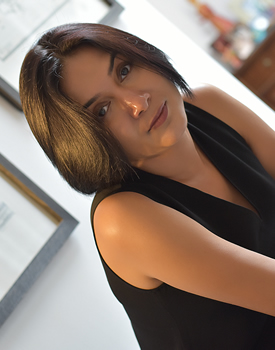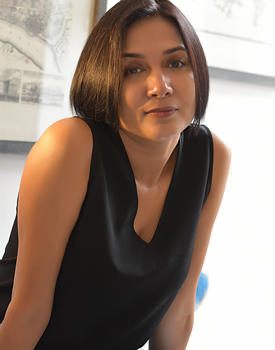

Features On the Cover: Damyanti Biswas
Earning Every Word
 By Dawn Ius
By Dawn Ius
Some authors would have you believe that they enjoy the “act of writing.” That they love the ability to sink into another character’s head and navigate a new world.
Damyanti Biswas is not that author.
Biswas freely admits that the joy she hopes to find from writing has yet to appear—she writes because she must. Because every time she tries not to, she finds herself back at the computer painstakingly pecking out every word, every sentence, every paragraph.
The irony, perhaps, is that Biswas makes it look easy. Her latest release, THE BLUE BAR, is a meticulously crafted police procedural set in Mumbai, where the setting—both the Bollywood glitz and the city’s seedy underworld—comes to life with such intensity you can almost smell the air.
In THE BLUE BAR, Biswas introduces us to a serial killer, a missing dancer, and the gritty detective on their trail. It is a story of love, murderous obsession, and second chances. And thankfully, it’s the first in a new series. It’s no surprise that the book is racking up accolades, including a coveted Amazon #1 New Release banner.
Here, Biswas talks with The Big Thrill about her inspirations for THE BLUE BAR, what Hollywood gets right—and wrong—about Mumbai, and why she works so hard for every word.
In a tweet you shared, THE BLUE BAR is described as “Indian noir.” I love that description—and I know you do as well. Why does it resonate so much with you?
To me, noir fiction is gritty, mostly urban, and often literary, expressing a view of human nature that is grim and unrelenting. My work tends to be realistic and gritty, and THE BLUE BAR is no exception. It is on the dark end of the crime fiction scale, and like most noir fiction, features a detective battling against destructive, corrupt forces.
I’d read and loved authors like Raymond Chandler and Dashiell Hammett, and had always wanted to read noir fiction in an Indian setting. Sacred Games by Vikram Chandra was an early example, but I wanted more. Once I’d finished THE BLUE BAR, the publishers called it a thriller, but in my heart I’ve secretly pegged it as Indian noir. Indian literary fiction has done well internationally, but genre fiction has yet to be recognized. I do hope Indian noir becomes a thing some day, and THE BLUE BAR finds its niche.
I was mesmerized by the atmosphere that you created for THE BLUE BAR—such an interesting and mysterious backdrop, both gritty and glittery. I love all of the cultural nods you included as well. What elements of the locale were important for you to convey and why?
Some very well-known literary books are set in Mumbai. Salman Rushdie’s Midnight’s Children features Mumbai, as does Jeet Thayil’s Man Booker-shortlisted Narcopolis. Shantaram by Gregory David Roberts, Rohinton Mistry’s masterful Family Matters.
Fewer genre books set in Mumbai have found the readership they deserve: I’d absolutely recommend Sujata Massey’s excellent historical mysteries in the Perveen Mistry series, Vaseem Khan’s Baby Ganesh series, and Jerry Pinto’s Murder in Mahim.
While writing about Mumbai, I was hyper-aware of all the previous writing about the city, including of course nonfiction like Suketu Mehta’s Maximum City, and the New York Times bestselling, National Award-winning Behind the Beautiful Forevers by Katherine Boo. I knew I could never compete, and also that the structure of a crime novel doesn’t lend itself to long, poetic descriptions. I stuck to my story and the locales organic to that story.
In THE BLUE BAR we see Mumbai’s beaches, the connected Madh island, the marshlands, the skyscrapers and nightlife, its festivals and railways stations, but all of it is there due to story reasons. I hope to explore more of Mumbai in the sequel to THE BLUE BAR, the second installment of the Blue Mumbai series.
What do you think TV, film, or fiction gets wrong about Mumbai?
A lot of fiction and TV actually gets Mumbai quite spot on: Sacred Games and The Fame Game get a lot of it right. Some movies suffer under the weight of the Western gaze, reducing Mumbai to poetic shots of filth and stylized Bollywood dance numbers where the misery and might of Mumbai is packaged as a palatable feast for the consumption of the Western audience.
I haven’t watched Shantaram yet but would definitely recommend movies like The Lunch Box and Dhobi Ghaat to anyone who might like a taste of authentic stories set in Mumbai.
It’s clear you did tremendous research into the seedy underworld and organized crime in Mumbai, in addition to the glittery Bollywood side of things. Was there anything that surprised you during your research? Was there one “side” that was easier to write?
All of it surprised me, and none of it did.
I’d read quite a few books set in Mumbai, about its mafia, its dance bars, which are very different from strip clubs, and about its contrasts between the rich and the poor. Since Bollywood is one of the biggest centers of film industry in India, I’d watched my share of Hindi movies that depicted Mumbai’s claustrophobia, glamor, and the fast life.
What shocked me was how much of what I’d already known from books and TV was true to life, but also, the human capacity for endurance under duress. Mumbaikars take floods, terrorist attacks, and mafia dons all in stride and move on. If there could be one word for the city, it would be resilience.
All of it was a challenge to write, because throughout the editorial process, I was concerned not just with the authenticity of what I’d written and respect for my characters, but also how the story would translate to someone who’d never been to Mumbai. I wanted to do this without preaching or long educational passages, and I do hope I’ve succeeded somewhat.
I read that the initial story for THE BLUE BAR came to you in 2017, and the journey to completion has been slow. What was holding you back? And what was the catalyst for finishing it?
After my initial inspiration in 2017, I wrote a different novel, and then the first draft of THE BLUE BAR in a month in 2019. It ended up losing me my then-agent. I had to go back to the querying trenches, find a business partner once again, and with my new agent put the novel through its paces to make sure it was publishable in the US market. So internally, there was no block, and no need for a catalyst. The external situation was a whole different ball game altogether.
You’ve said that writing is not so much a joy for you but more of a compulsion. Can you share a little more about that?
I possess no talent for writing, so it’s all a slog. I must keep fiddling and tinkering, tossing entire drafts and swearing I’ll never write again before I can get anything finished. I can’t give up writing, though. I’ve tried. I go right back to writing terrible first drafts.
I’m usually happier once I have written. I’m in no joy during the process itself (well, maybe satisfaction on the days the words are easier or a plot solution suggests itself) and not easy to be with—just ask my long-suffering spouse.
Arnav—the detective at the center of this book—is such a richly developed character. Who inspired Arnav and when did the character really come into focus for you?
I don’t know that anyone inspired Arnav. Not many of my characters take after real people. I begin a story with characters: their wants, their needs, their wounds, their moral flaws, but in THE BLUE BAR, Tara came first. I realized she was in love with a constable, and that was when Arnav came on stage. Once I asked myself what his wounds were, he turned interesting, and I went digging from there.
My characters are usually composites of observation and imagination, but after the initial stages, they bear no resemblance to anyone I know, alive or dead.
As propulsive and gritty as this book is, THE BLUE BAR also weaves in a romantic thread. What was the most challenging aspect of combining these elements?
The timelines. The “present” timeline of the THE BLUE BAR is set within the exact 20 days from Dussehra to Diwali, so it was challenging to keep things straight with both the romance and mystery aspects. Finally, I edited out the romance wherever needed in order to give space to the investigation. I send out a One-shot gazette each month to subscribers, and that was where a lot of the romance/character scenes from the editing floor found a new home.
Although THE BLUE BAR is getting incredible reviews and well-earned praise, I know you’ve struggled with some racist comments since the book’s debut. This industry is tough enough without that, and I’m sorry you’ve had to deal with it. What strategies are you employing to try and push aside those opinions (or deal with them) and focus on all of the good?
Honestly, it’s been hard. I’m the first college-educated woman in my family—which wasn’t easy. I’ve been bullied all my life, so the whole experience of racist attacks on the THE BLUE BAR has been triggering, recalling a lifetime worth of trauma. I’d expected to receive some racism, but I wasn’t prepared for the extent of it (my DMs have been flooded), and how it would affect me. I’m fine with readers panning my book for its craft, but not my identity. Racism is not criticism.
I didn’t have to find coping strategies because THE BLUE BAR was part of a two-book deal, and I’m working on deadline for the sequel’s developmental edits. When you’re being creative and drilling down into a story, there’s no time or patience to read or counter racist reviews. My current take is to let things take their course. Discerning readers know troll reviews from genuine low stars. I’ve said my piece against racism and will continue to speak out whenever I encounter it.
What do you hope readers take away from this story?
Readers should feel free to come to their own conclusions. I write for one or two ideal readers, and they’ve called the book an exploration of love in all its forms and of second chances in life. Of justice, how relative it can be, and how rare it is.
Once the book goes into print, it isn’t mine any more. It belongs to readers, and I can only hope readers are engaged and entertained. Each reader brings their own upbringing and experience to a book, so I don’t know what they’ll take away from THE BLUE BAR. But I pray they remember Arnav and Tara and see the beauty of love, second chances, and its ability to wipe out decades of negativity.
THE BLUE BAR is the first in a series—and it’s a compelling beginning! What can you share about the second installment, including when we can get our grabby hands on it?
THE BLUE BAR was written as a standalone and had a different ending. My wonderful editor at Thomas & Mercer wanted to buy two books instead of one and liked Arnav Singh Rajput enough to buy a second book in the series without even a logline.
So here I am, writing my first series, the Blue Mumbai. My publisher has been kind enough to create me a character bible and a timeline sheet, so it is less daunting than it might have been. The sequel is tentatively titled Blue Black Hair. It’s set again in Mumbai. It involves the hair industry, caste, and castration, and while you try to connect those in your reading brain, I can tell you that it will be out 24th October, 2023, and is already available on pre-order!
- On the Cover: Alisa Lynn Valdés - March 31, 2023
- On the Cover: Melissa Cassera - March 31, 2023
- Behind the Scenes: From Book to Netflix - March 31, 2023



